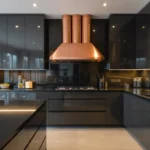Look, I get it. You’re staring at your living room and dining area wondering how the heck you’re supposed to make them work together without looking like a furniture store exploded. Maybe you’re working with a small apartment where everything bleeds into everything else, or perhaps you’ve got an open-concept space that feels more “empty warehouse” than “cozy home.” Either way, you’re not alone in this struggle.
I’ve been there—trust me. I once tried to cram a dining table into a space that clearly wanted nothing to do with it, and the result was… well, let’s just say my guests kept bumping into chair backs while trying to watch TV. Not cute. But here’s the thing: combining your living and dining areas doesn’t have to be a design nightmare. Actually, it can be pretty awesome when you know what you’re doing.
So grab your coffee (or wine, no judgment here), and let’s talk through 15 creative ways to make your living and dining room combo actually work. These aren’t just theoretical Pinterest dreams—these are real, actionable ideas that actual humans can pull off.
1. Cozy Open-Concept Lounge & Dining Blend

Ever notice how the best combo spaces feel like one big, cohesive room rather than two awkward zones fighting for dominance? That’s exactly what you want here.
The key is creating flow without sacrificing function. Start by positioning your sofa with its back to the dining area—this creates a natural room divider without blocking sightlines or making the space feel choppy. I did this in my last place, and honestly? Game-changer.
Use a large area rug to anchor your living space, then let your dining table sit on either hardwood or a complementary rug. This subtle shift in flooring helps define each zone while keeping everything connected. Add some cozy throws, plush cushions, and warm lighting to both areas so they feel like they’re part of the same conversation.
Pro tip: Keep your color palette consistent across both zones. When your sofa pillows echo the dining chair cushions, everything just clicks.
2. Scandinavian Minimalist Combo Space
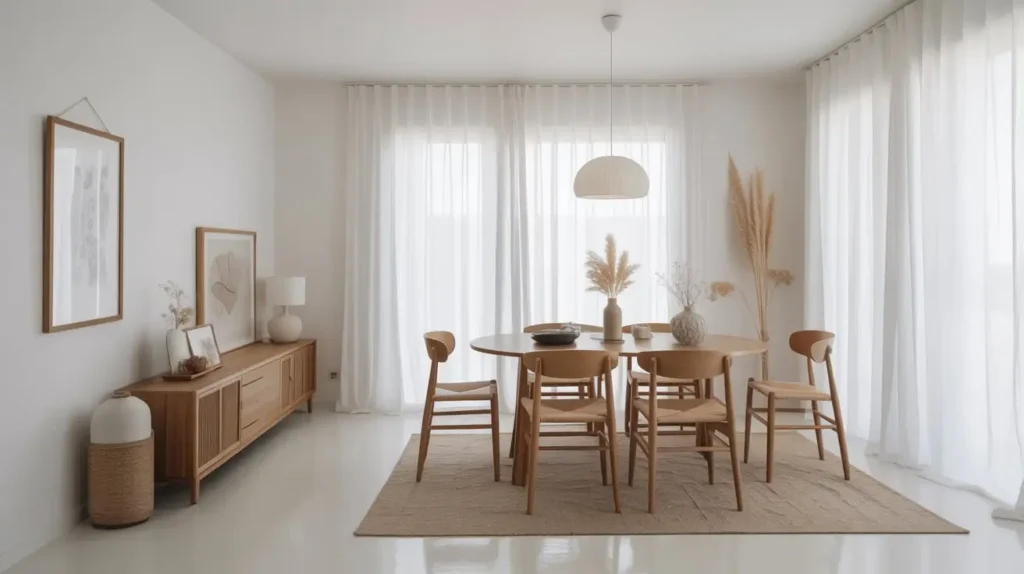
If you’re into that clean, uncluttered vibe (and let’s be honest, who isn’t these days?), Scandinavian design is your best friend for combo spaces.
Think white walls, light wood furniture, and strategic pops of black or gray. The beauty of Scandi style is that it makes even small spaces feel airy and open. You’re working with a minimal color palette, which automatically creates cohesion between your living and dining areas.
Go for a simple wooden dining table—preferably with those gorgeous tapered legs—and pair it with modern, streamlined chairs. Your sofa should follow the same principle: clean lines, neutral upholstery, maybe a light gray or beige. Throw in some greenery (because Scandi design without plants is basically illegal), and you’ve got yourself a combo space that feels calm and intentional.
The best part? This style practically forces you to declutter, which means your combo space won’t feel cramped or chaotic.
3. Modern Farmhouse Living-Dining Harmony
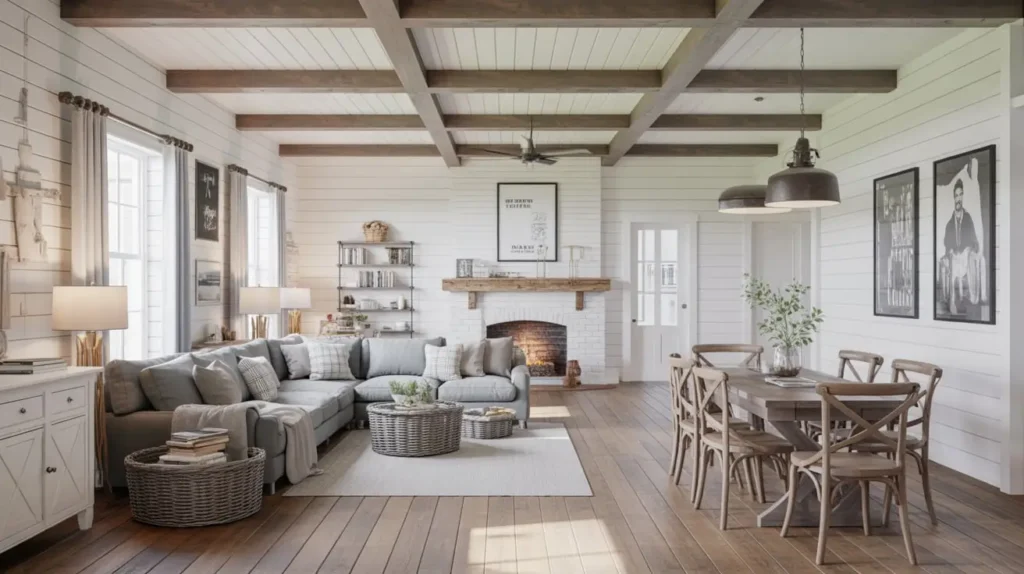
Okay, I know modern farmhouse is everywhere right now, but hear me out—there’s a reason this style works so well for combo spaces.
Modern farmhouse blends rustic charm with contemporary comfort, which gives you tons of flexibility. You can mix a reclaimed wood dining table with a modern sectional and somehow make it look intentional. It’s design magic, honestly.
Key elements to nail this look:
- Shiplap or board-and-batten walls (or even just one accent wall if you’re not going full Chip and Joanna)
- Neutral color scheme with warm whites and soft grays
- Industrial-style light fixtures over the dining table
- Cozy textiles in the living area—think chunky knit throws and linen pillows
- Open shelving or a rustic buffet to bridge the two spaces
I love this style for combo rooms because it feels collected and lived-in rather than overly designed. Your guests will actually want to hang out here.
4. Neutral Tones with Natural Textures

Here’s a little secret: when you’re nervous about designing a combo space, neutrals are your safety net.
But neutral doesn’t mean boring (despite what that one design snob on Instagram might tell you). Layer different textures—linen, wool, jute, leather, wood—and suddenly your beige-on-beige room has serious depth and interest.
Start with a neutral base for your walls and large furniture pieces. Think creams, taupes, soft grays, and warm whites. Then build in texture through:
- A jute or sisal rug under the dining table
- Linen curtains that soften the windows
- Leather dining chairs or a leather accent chair in the living area
- Woven baskets for storage
- A chunky knit throw on the sofa
The genius of this approach is that everything naturally coordinates. You don’t have to stress about whether your dining chairs clash with your sofa because everything lives in the same tonal family.
Also Read: 15 Brilliant Very Small Living Room Ideas for Cozy Spaces
5. Compact Apartment Dual-Zone Design
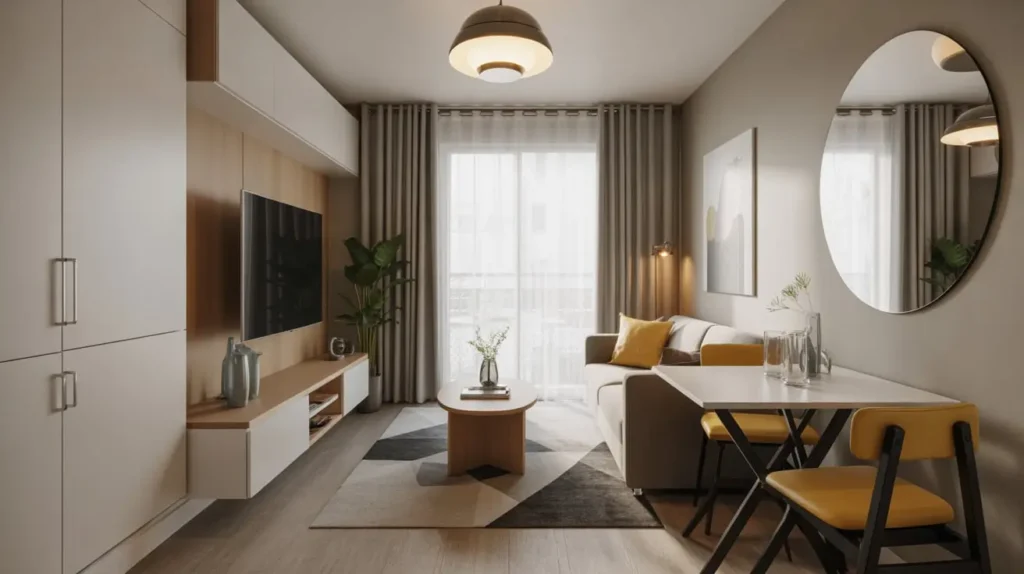
Small apartment? Yeah, me too. Let’s talk strategy.
When you’re working with limited square footage, every inch matters. You need furniture that pulls double duty and layouts that maximize functionality without making the space feel like a sardine can.
Here’s what actually works:
- Round dining tables instead of rectangular (they take up less visual space and you can squeeze more people around them)
- A loveseat or apartment-sized sofa instead of a full sectional
- Wall-mounted shelving to keep the floor clear
- Nesting tables in the living area that you can tuck away
- Mirrors strategically placed to bounce light and create the illusion of more space
I learned this the hard way in my 600-square-foot apartment: furniture placement makes or breaks a small combo space. Float your sofa in the middle of the room if you have to, rather than shoving everything against the walls. Counterintuitive? Absolutely. But it actually creates better flow and makes the space feel larger.
6. Mid-Century Chic Shared Space
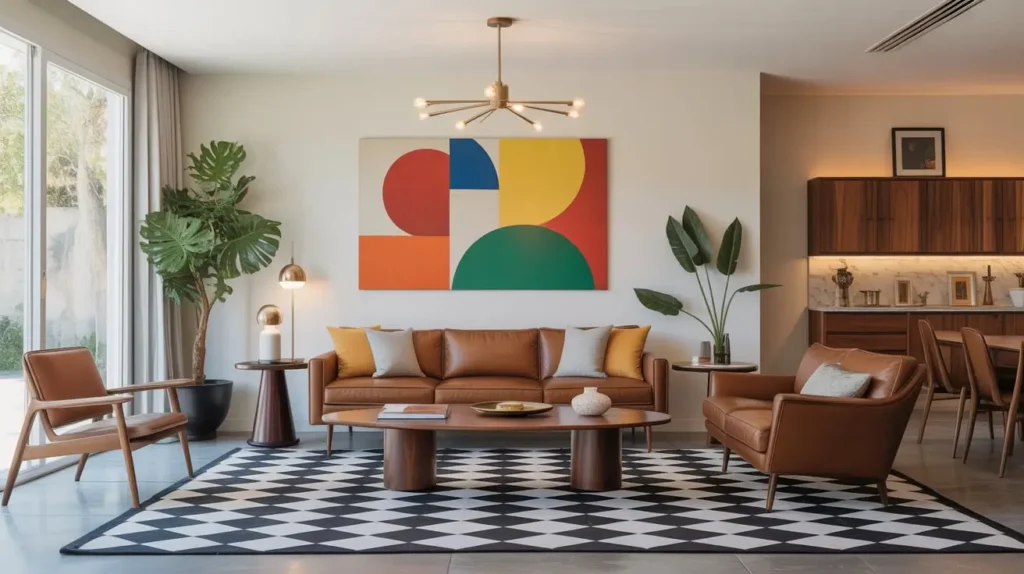
Can we take a moment to appreciate mid-century modern design? Because IMO, this style was basically made for combo spaces.
Mid-century furniture has clean lines and elevated legs, which means it doesn’t visually weigh down your space. You get all the functionality without the bulk—perfect for areas where you’re trying to fit multiple functions.
For your living area, go for a classic mid-century sofa with those iconic tapered wooden legs. Add a credenza (seriously useful for storage) and maybe a sculptural floor lamp. In the dining zone, grab a simple wooden table—Tulip tables are peak mid-century if you want to go full vintage vibes—and some molded plastic or upholstered chairs.
The color palette? You’ve got options. Go full retro with mustard yellows and burnt orange, or keep it modern with a more subdued palette of walnut wood tones, white, and black accents.
FYI, vintage mid-century pieces can get pricey, but there are tons of affordable reproductions out there that nail the look without breaking the bank.
7. Rustic Industrial Fusion Layout
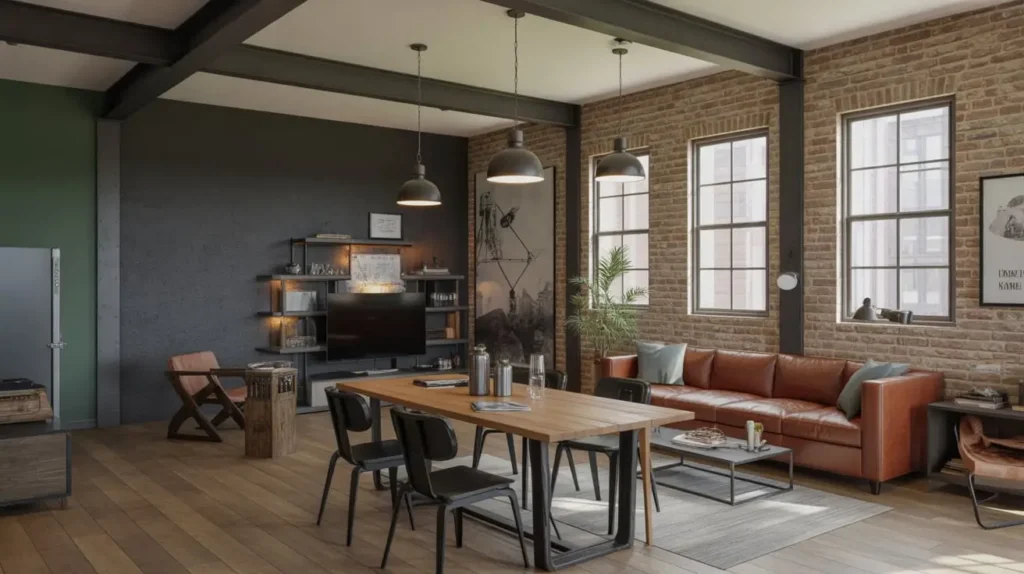
Ever walked into one of those converted warehouse lofts and thought, “Okay, this is cool”? That’s rustic industrial, and you can totally recreate that vibe in a combo space.
This style mashes up raw industrial elements with warm, rustic touches. Think exposed brick (or brick-look wallpaper if you’re faking it), metal light fixtures, reclaimed wood, and leather accents.
Your dining table should be chunky and substantial—reclaimed wood with metal legs hits that sweet spot. Pair it with industrial-style metal chairs, or mix in some upholstered seating to soften the look. For the living area, a leather sofa or a fabric one in a rich, warm color works great.
Don’t forget the details:
- Edison bulb pendant lights over the dining table
- Metal and wood shelving units
- Vintage-inspired accessories
- A statement piece like an old factory cart repurposed as a coffee table
The trick is balancing the hard industrial elements with enough warmth that the space still feels inviting. Nobody wants to eat dinner in a literal warehouse, you know?
8. Elegant Contemporary Open Plan

Sometimes you just want your space to feel grown-up and sophisticated. No judgment—I get that too.
Contemporary design is all about sleek lines, minimal ornamentation, and quality materials. This works beautifully in combo spaces because the streamlined aesthetic creates visual continuity.
Go for a low-profile sectional in a rich, solid color—think charcoal, navy, or even a bold jewel tone if you’re feeling adventurous. Your dining table should be equally sleek, maybe with a glass or marble top and simple metal or wooden legs.
Lighting is huge here. Install statement pendant lights over the dining table and use recessed lighting or modern floor lamps in the living area. Contemporary design loves good lighting.
Keep accessories minimal but impactful. A large piece of abstract art, a sculptural vase, or a carefully curated coffee table book collection adds personality without clutter.
9. Boho-Chic Flowing Living-Dining Setup
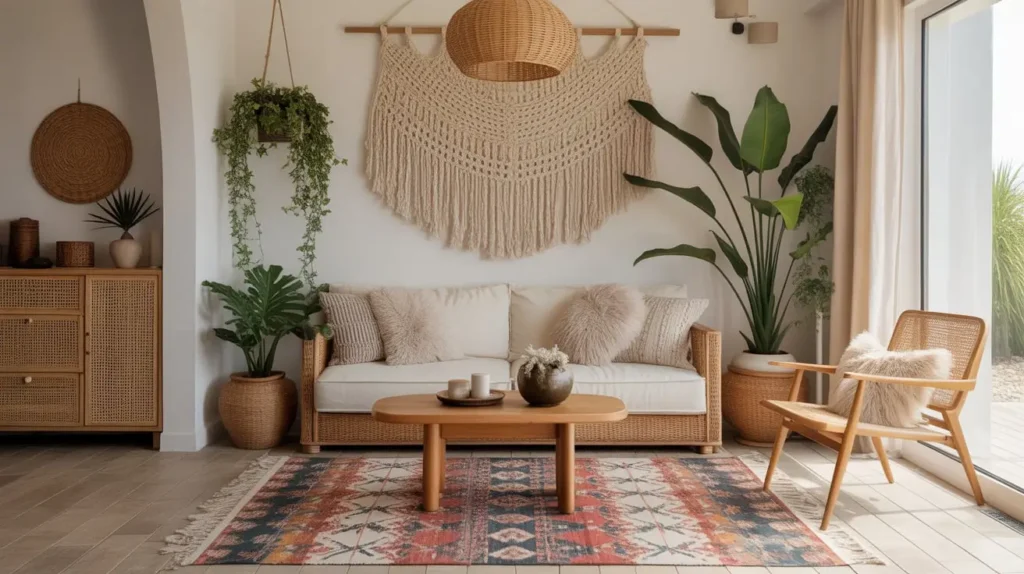
If you’ve ever described your style as “eclectic” or “collected,” boho is probably calling your name.
Boho design gives you permission to mix patterns, textures, and eras in a way that would make traditional designers twitch. But here’s the thing: it works, especially in combo spaces where you want the living and dining areas to feel connected but distinct.
Layer it up:
- A vintage or distressed dining table with mismatched chairs (yes, really)
- A comfy sofa loaded with pillows in different patterns and textures
- Macramé wall hangings, woven baskets, and plants everywhere
- A Moroccan or Turkish rug anchoring the living area
- Rattan or wicker accent pieces
The key to pulling off boho without it looking messy is to stick to a cohesive color story. Even with all that mixing and matching, keeping your colors in the same family creates harmony.
Plus, boho is super forgiving. Got a random vintage find at a flea market? It’ll probably fit right in. 🙂
10. Japandi Style Calm and Cohesion

Japandi—a mashup of Japanese and Scandinavian design—is having a serious moment, and honestly? It’s perfect for combo spaces.
This style combines Japanese minimalism with Scandinavian coziness, resulting in spaces that feel zen but still livable. You get clean lines, natural materials, a neutral palette, and just enough warmth to keep things from feeling cold.
For furniture, think low-profile pieces with simple, elegant lines. A Japanese-style dining table in light wood, simple chairs (maybe with subtle cushions), and a streamlined sofa in the living area. Everything should feel intentional and uncluttered.
Your color palette should be:
- Warm whites and creams
- Soft grays
- Natural wood tones
- Maybe a touch of black for contrast
Add in some handcrafted ceramic pieces, a few carefully chosen plants, and textiles in natural fibers like linen or cotton. The result? A combo space that feels like a deep breath after a chaotic day.
Also Read: 15 Cozy Living Room Decor Ideas for a Warm Ambiance
11. Light and Airy Small Space Solution
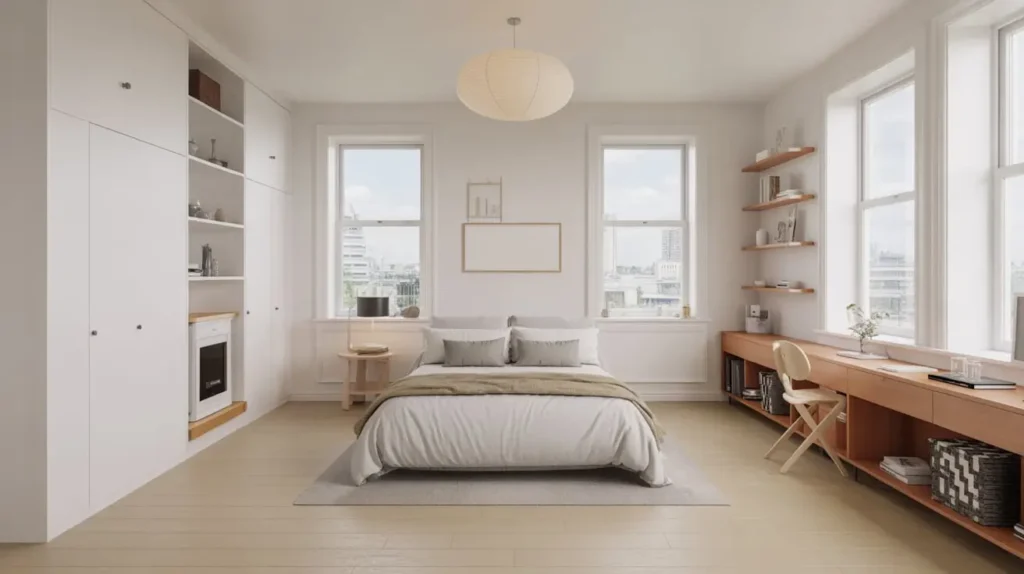
When your combo space is on the smaller side, your main goal is making it feel as open and uncrammed as possible. Light and airy is your design strategy.
Stick to a light color palette—whites, creams, soft pastels, and pale grays. Dark colors can look amazing, but they’ll make a small space feel even smaller. Save the drama for a bigger room.
Your furniture should be:
- Appropriately scaled (no massive sectionals in a tiny room, please)
- Elevated on visible legs to create visual space underneath
- Ideally in light colors or natural wood tones
Maximize natural light by keeping window treatments minimal—sheer curtains or simple blinds work great. If you’re short on natural light, layer in plenty of ambient lighting with table lamps, floor lamps, and maybe some string lights for ambiance.
Mirrors are your best friend here. A large mirror on one wall can literally double the perceived space. It’s basically cheating, but the good kind.
12. Bold Contrast Urban Loft Combo

Ready to make a statement? Good, because this one’s all about drama.
Urban loft style embraces bold contrasts and isn’t afraid of making waves. Think black window frames against white walls, dark furniture against light floors, or a bold accent wall anchoring the dining area.
You might use:
- A black dining table with modern chairs in the dining zone
- A statement sofa in a rich, dark color or bold pattern
- Black metal light fixtures
- Crisp white walls to let the dark elements pop
- Industrial or contemporary accessories
The beauty of this approach is that the high contrast naturally defines your different zones. The bold elements draw the eye and create visual anchors that help separate the living and dining functions without needing physical dividers.
Just don’t go overboard. You want bold, not overwhelming. Balance is still your friend.
13. Classic Meets Modern Transitional Layout
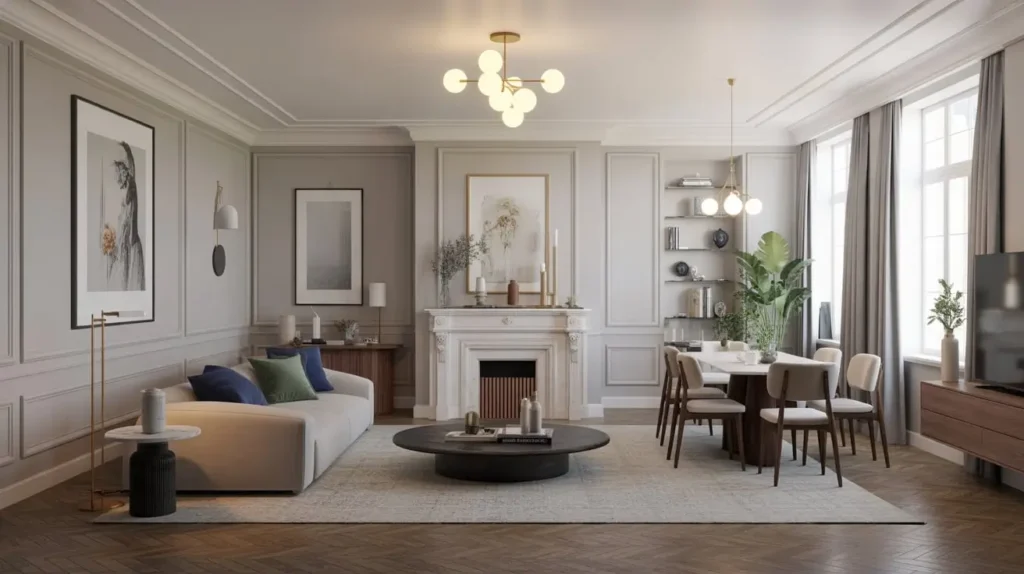
Can’t decide between traditional and contemporary? Transitional style says “why not both?”
Transitional design blends classic elegance with modern simplicity, and it’s actually genius for combo spaces because it gives you tons of flexibility. You can mix that traditional dining table you inherited from your grandmother with a modern sofa and make it work.
Key characteristics:
- Neutral color palette (we’re talking grays, beiges, creams, whites)
- Mix of curved and straight lines
- Both traditional and modern materials
- Understated elegance rather than fussy details
Your dining area might have a traditional wooden table with upholstered chairs that have a modern silhouette. Your living area could feature a contemporary sofa paired with a classic wooden coffee table. The key is finding the middle ground where both styles shake hands and play nice.
This approach works great if you’re sharing space with a partner who has different style preferences. It’s basically the compromise style, and there’s nothing wrong with that.
14. Cozy Corner Dining Beside the Sofa
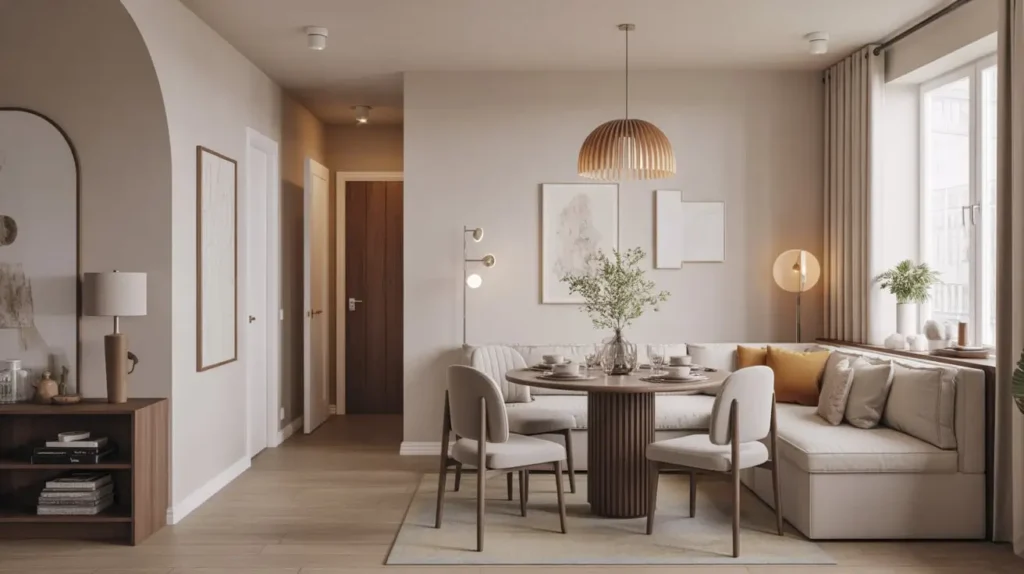
Okay, this one’s for those awkward spaces where you’re really squeezing things in. Sometimes you’ve gotta get creative with placement.
A corner dining setup can actually be super cozy and functional. Position a round or square table in a corner near your living area, add a bench along one or two walls, and throw in some comfy cushions. Boom—you’ve got a breakfast nook vibe that maximizes your space.
This works especially well when:
- You don’t need to seat a ton of people regularly
- Your space is oddly shaped or has a natural corner nook
- You want the dining area to feel more casual and integrated
The trick is making it feel intentional rather than “we ran out of room everywhere else.” Add a pendant light over the table to define the zone, use cushions that coordinate with your living room colors, and maybe hang some art on the adjacent walls to make it feel like a designed feature.
I’ve seen people pull this off beautifully in studio apartments where space is at a premium. Sometimes thinking outside the box (or outside the traditional dining room layout) is exactly what you need.
15. Monochrome Modern Open Layout
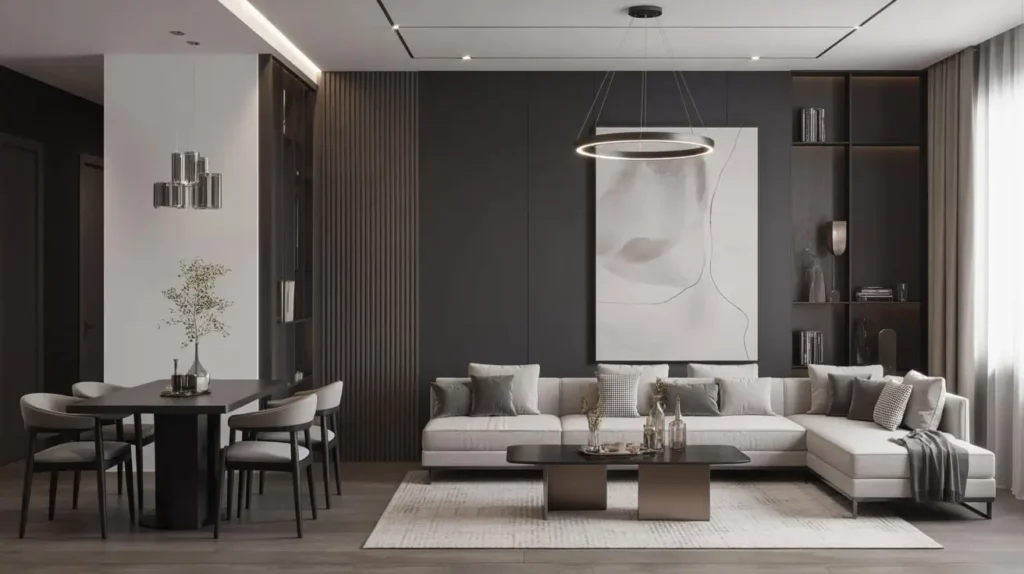
Last but definitely not least, let’s talk about monochrome—specifically black, white, and gray.
A monochrome palette creates instant cohesion in a combo space because, well, everything already matches. You’re working within a limited color range, which means your living and dining areas automatically feel connected.
Start with a base of white or light gray walls, then layer in darker elements:
- A charcoal gray sofa in the living area
- Black dining chairs with a white or light wood table
- Black and white artwork
- Gray textiles and accessories
- Varied textures to prevent the space from feeling flat
The beauty of monochrome is that it feels sophisticated and modern without being complicated. You don’t need to stress about color coordination because you’re essentially working in grayscale.
Add warmth through:
- Natural wood accents
- Varied textures like velvet, linen, and leather
- Metallics like brass or chrome for a bit of shine
- Strategic lighting to create depth and interest
Some people worry monochrome will feel cold or boring, but honestly? When you layer textures and play with different shades within your palette, it can feel incredibly rich and dynamic.
Wrapping It All Up
Look, designing a living and dining room combo doesn’t have to give you a headache. Whether you’re working with a tiny apartment or a sprawling open-concept space, the key is choosing a cohesive style and sticking with it.
You don’t need to copy any of these ideas exactly—mix and match elements that speak to you. Love the clean lines of Scandinavian design but want some boho textiles? Go for it. Want mid-century furniture with farmhouse accents? Why not?
The most important thing is creating a space that actually works for how you live. If you never eat formal dinners, don’t force a massive dining table into your layout just because you think you’re supposed to. If you love entertaining, make sure your setup facilitates conversation and flow.
And remember: your space doesn’t need to be Instagram-perfect to be perfect for you. The best combo rooms are the ones where you actually want to spend time—not the ones that look great but feel like a museum.





